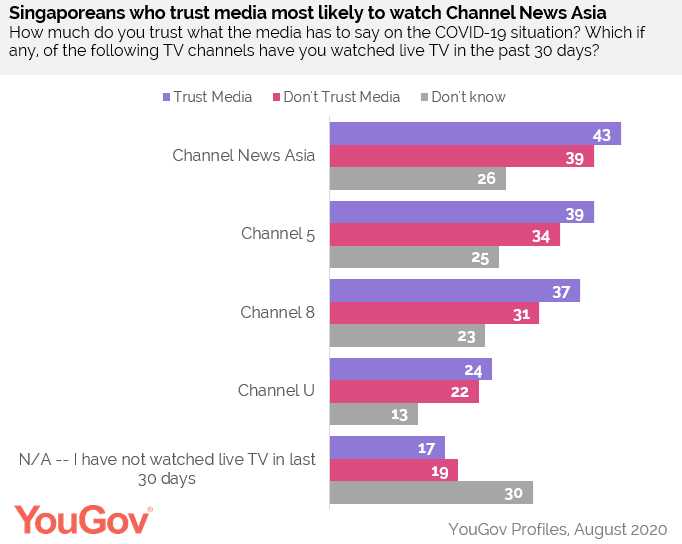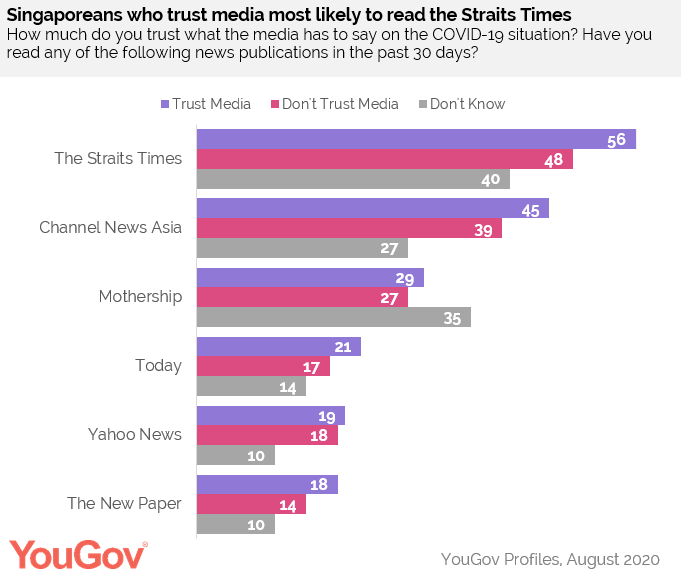Which media outlet enjoys the trust of Singaporean consumers? YouGov’s Ervin Ha takes a look at where Singaporeans chose to get their news and updates on COVID-19 from.
The media has played a huge role during the COVID-19 pandemic, in keeping Singaporeans updated on the unpredictable and rapidly developing situation. Using YouGov Profiles data, we took a look at the different attitudes towards the media, and which publications the trusting and distrustful consume.
Seven in ten (71%) of Singaporeans say they trust media reporting on COVID-19, of which three in ten (63%) are ‘somewhat’ trusting, and almost one in ten (8%) completely trust the media. A quarter (25%) distrust the media, with one in twenty (4%) distrusting media reporting on COVID-19 completely. The remaining 3% are undecided. Those over 45 years of age are the most likely to trust the media (74%), and those aged 25 to 34 are the least likely (69%). Men are also more likely to distrust the media than women (28% vs. 23%).
Using the YouGov BrandIndex Current Customer score – which looks at which media publications people have watched/read in the past 30 days we can see there is also a difference in the publications that Singaporeans consume, depending on their trust or distrust of the media.
Looking at TV, those who trust media reporting on COVID-19 are most likely to watching Channel News Asia –43% of those who trust media, compared to 39% who do not. This is followed by Channel 5 (39% vs. 34%), Channel 5 (39% vs. 34%), Channel 8 (37% vs. 31%) and Channel U (24% vs. 22%). Those who are unsure of their level of trust for the media are the most likely to not have watched live TV in the last 30 days – with three in ten (30%) saying so.

Those who trust media reporting on COVID-19 are also more likely to read certain publications. They are the most likely to read The Straits Times, with over half (56%) having done so in the past 30 days, compared to under half (48%) of those who distrust the media. Also popular with those who trust the media are Channel News Asia (45% vs. 39%), Today (21% vs. 17%) and The New Paper (18% vs. 14%). Amongst those who neither trust nor distrust the media, the most popular publication is Mothership (35% vs. 29% who trust media vs. 27% who don’t trust media).

The level of trust one has for the media is also reflected in how well they think the government is handling the pandemic. Amongst those who trust the media, two in ten (19%) think the government is doing ‘very well’, and seven in ten (68%) think they are doing ‘fairly well’. However, compared to those who do not trust media reporting on COVID-19, only one in ten (10%) think they are doing ‘very well’, and only half (49%) think they are doing ‘fairly well. Conversely, amongst those who distrust the media, over one in ten (12%) think the government is doing ‘very badly’ – six times higher than those who trust the media (2%).

It’s perhaps unsurprising that a significant amount of Singaporeans are expressing distrust over media reporting on COVID-19, a sentiment iterated globally. Our data shows that distrust is particularly so for the younger generations and that certain publications are favoured – something marketers and media planners to take note of when attempting to reach out to this demographic, and when looking where to place their key messaging.

